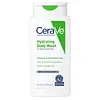What's inside
What's inside
 Key Ingredients
Key Ingredients

 Benefits
Benefits

 Concerns
Concerns

 Ingredients Side-by-side
Ingredients Side-by-side

Water
Skin ConditioningCocamidopropyl Betaine
CleansingPetrolatum
EmollientLauric Acid
CleansingSodium Cocoyl Glycinate
CleansingGlycerin
HumectantGlycine Soja Oil
EmollientUrea
BufferingStearic Acid
CleansingSodium Cocoyl Isethionate
CleansingSodium Hydroxypropyl Starch Phosphate
AbrasiveSodium Lauroamphoacetate
CleansingSodium Methyl Cocoyl Taurate
CleansingSodium Chloride
MaskingCeramide 3
Skin ConditioningCeramide 6 Ii
Skin ConditioningCeramide 1
Skin ConditioningHyaluronic Acid
HumectantPhenoxyethanol
PreservativeGuar Hydroxypropyltrimonium Chloride
Skin ConditioningSodium Hydroxide
BufferingSodium PCA
HumectantOphiopogon Japonicus Root Extract
Skin ConditioningTetrasodium EDTA
Ethylhexylglycerin
Skin ConditioningSodium Lauroyl Lactylate
EmulsifyingPhytosphingosine
Skin ConditioningCholesterol
EmollientCarbomer
Emulsion StabilisingXanthan Gum
EmulsifyingWater, Cocamidopropyl Betaine, Petrolatum, Lauric Acid, Sodium Cocoyl Glycinate, Glycerin, Glycine Soja Oil, Urea, Stearic Acid, Sodium Cocoyl Isethionate, Sodium Hydroxypropyl Starch Phosphate, Sodium Lauroamphoacetate, Sodium Methyl Cocoyl Taurate, Sodium Chloride, Ceramide 3, Ceramide 6 Ii, Ceramide 1, Hyaluronic Acid, Phenoxyethanol, Guar Hydroxypropyltrimonium Chloride, Sodium Hydroxide, Sodium PCA, Ophiopogon Japonicus Root Extract, Tetrasodium EDTA, Ethylhexylglycerin, Sodium Lauroyl Lactylate, Phytosphingosine, Cholesterol, Carbomer, Xanthan Gum
Water
Skin ConditioningCoco-Betaine
CleansingDisodium Cocoyl Glutamate
CleansingCitric Acid
BufferingCetyl Hydroxyethylcellulose
Emulsion StabilisingCeramide NP
Skin ConditioningCeramide AP
Skin ConditioningCeramide EOP
Skin ConditioningCarbomer
Emulsion StabilisingTriethyl Citrate
MaskingSodium Chloride
MaskingSodium Cocoyl Glutamate
CleansingSodium Phytate
Sodium Lauroyl Lactylate
EmulsifyingSodium Hyaluronate
HumectantCholesterol
EmollientDisodium EDTA
Tocopheryl Acetate
AntioxidantCapryloyl Glycine
CleansingCaprylyl Glycol
EmollientPhytosphingosine
Skin ConditioningXanthan Gum
EmulsifyingBenzoic Acid
MaskingWater, Coco-Betaine, Disodium Cocoyl Glutamate, Citric Acid, Cetyl Hydroxyethylcellulose, Ceramide NP, Ceramide AP, Ceramide EOP, Carbomer, Triethyl Citrate, Sodium Chloride, Sodium Cocoyl Glutamate, Sodium Phytate, Sodium Lauroyl Lactylate, Sodium Hyaluronate, Cholesterol, Disodium EDTA, Tocopheryl Acetate, Capryloyl Glycine, Caprylyl Glycol, Phytosphingosine, Xanthan Gum, Benzoic Acid
 Reviews
Reviews

Ingredients Explained
These ingredients are found in both products.
Ingredients higher up in an ingredient list are typically present in a larger amount.
Carbomer is a polymer of acrylic acid. Its main role is to create a gel consistency.
A high amount of carbomer can cause pilling or balling up of products. Don't worry, most products contain 1% or less of carbomer.
Cholesterol is a class of organic molecules called lipids. It helps hydrate your skin and is essential to having a healthy skin barrier.
Our skin naturally contains cholesterol in the outermost layer. Besides cholesterol, it also contains ceramides and fatty acids. Cholesterol makes up about 1/4 of your skin's outer layer and barrier. Your skin barrier is responsible for keeping allergens and microbes out. Having a healthy skin barrier is also responsible for keeping your skin firm and plump.
Our bodies use cholestrol to create vitamin D, steroid hormones, and more.
Learn more about CholesterolPhytosphingosine is a phospholipid naturally found in our skin as a building block for ceramides.. It helps moisturize, soothe, and protect skin.
Phytosphingosine contributes to your skin's natural moisturizing factor (NMF). The NMF is responsible for hydration, a strong barrier, and plasticity. Our NMF decreases with age. Increasing NMF leads to more healthy and hydrated skin.
Studies show products formulated with NMF ingredients help strengthen our skin's barrier. Having a healthy skin barrier reduces irritation and increases hydration. Our skin barrier is responsible for having plump and firm skin. It also helps protect our skin against infection, allergies, and inflammation.
Fun fact: Phytosphingosine is abundant in plants and fungi.
More ingredients that help boost collagen in skin:
Learn more about PhytosphingosineChances are, you eat sodium chloride every day. Sodium Chloride is also known as table salt.
This ingredient has many purposes in skincare: thickener, emulsifier, and exfoliator.
You'll most likely find this ingredient in cleansers where it is used to create a gel-like texture. As an emulsifier, it also prevents ingredients from separating.
There is much debate on whether this ingredient is comedogenic. The short answer - comedogenic ratings don't tell the whole story. Learn more about comegodenic ratings here.
The concensus about this ingredient causing acne seems to be divided. Research is needed to understand if this ingredient does cause acne.
Scrubs may use salt as the primary exfoliating ingredient.
Learn more about Sodium ChlorideSodium Lauroyl Lactylate is the lauric acid sodium salt of lactyl lactate.
Sodium Lauroyl Lactylate is an emulsifier and surfactant.
Emulsifiers help stabilize a product. They do this by preventing ingredients from separating, such as oils and water which do not mix naturally. Surfactants reduce surface tension, making it easier to rinse pollutants off skin.
Due to its relation to lauric acid, it may provide antimicrobial benefits.
Learn more about Sodium Lauroyl LactylateWater. It's the most common cosmetic ingredient of all. You'll usually see it at the top of ingredient lists, meaning that it makes up the largest part of the product.
So why is it so popular? Water most often acts as a solvent - this means that it helps dissolve other ingredients into the formulation.
You'll also recognize water as that liquid we all need to stay alive. If you see this, drink a glass of water. Stay hydrated!
Learn more about WaterXanthan gum is used as a stabilizer and thickener within cosmetic products. It helps give products a sticky, thick feeling - preventing them from being too runny.
On the technical side of things, xanthan gum is a polysaccharide - a combination consisting of multiple sugar molecules bonded together.
Xanthan gum is a pretty common and great ingredient. It is a natural, non-toxic, non-irritating ingredient that is also commonly used in food products.
Learn more about Xanthan Gum